Click to Skip Ahead
Parrots are popular pets, especially among bird enthusiasts who like interacting with their pets. These boisterous birds are well-known for their exceedingly talkative nature. Many will even hold conversations with their owners and go out of their way to get attention with their voices. Most people consider this to be rather cute, but it can also get overwhelming.
Double Yellow-Headed Amazon Parrots can make excellent pets but only for the right people. In this article, we go over their temperament and care needs so you can determine if they’ll be a suitable bird for you.

Double Yellow-Headed Amazon Parrot Species Overview
| Common Names: | Double Yellow-Headed Amazon, Yellow-Headed Amazon, Yellow-Headed Parrot |
| Scientific Name: | Amazona oratrix |
| Adult Size: | 15–17 inches |
| Life Expectancy: | 60–80 years |
Origin and History
The Double Yellow-Headed Amazon Parrot is native to Central and South America. They naturally live in forests and woods near water but not necessarily in rainforests. Their population is on the decline, mainly due to deforestation and trapping. Many individuals are removed from the wild to supplement the pet trade. Today, only a few thousand birds remain in the wild. They are considered an endangered species.1
Acquiring these birds is a bit difficult due to their endangered status. Documentation is required to ensure that the bird is captive-bred. Owning wild-caught birds is illegal.
Fortunately, Double Yellow-Headed Amazon Parrots are relatively easy to find in captivity. Many breeders do an excellent job of raising healthy specimens.
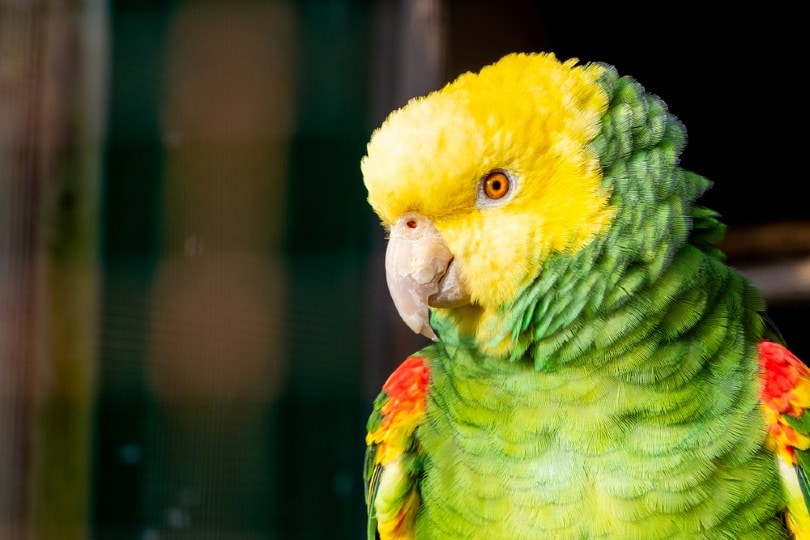
Temperament
Double Yellow-Headed Amazon Parrots can make excellent pets. Many captive-bred birds are hand-fed, starting when young. In these cases, they can make affectionate pets that quickly bond with their owners.
As an intelligent species, they can be a bit more of a handful than others. They enjoy being the center of attention, and problems occur most often when owners are unable to give their birds the attention that they need.
Usually, these birds are friendly and receptive to any attention. However, they may go through a hormonal stage around the time that they reach sexual maturity. Usually, this occurs around 4 months to 1 year. This behavior can last quite a long time, anywhere from several months to 2 years. During this time, this species may lunge and bite at unknown people. Some may even become aggressive toward their recently beloved owners. We don’t recommend this species for households with children for this reason. They may work better if you purchase them when they are older.
Most Double Yellow-Headed Amazon Parrots bond closely with one family member. They are one-person birds, so don’t purchase one if you’re looking for a species to bond with everyone equally. They won’t do it.
- Interactive
- Affectionate and social
- Intelligent
- Can be noisy
- Needs a great deal of attention and work
Speech & Vocalizations
The Double Yellow-Headed Amazon Parrot is one of the best mimics out there. If you’re looking for a parrot that will talk, this is an excellent species. They are considered second to only the African Gray Parrot in their ability to talk.
This parrot tends to be rather boisterous, though. They are not suitable for those looking for quieter birds. You may not want to adopt one in an apartment either. They are most noisy around dusk and dawn, though this can vary from bird to bird. Loud vocalizations are the norm for this species. Screaming can be a severe problem in some cases. Some birds may do it all day long.
Boredom usually leads to noisier behaviors. If you keep your bird entertained, they may not be quite as loud.
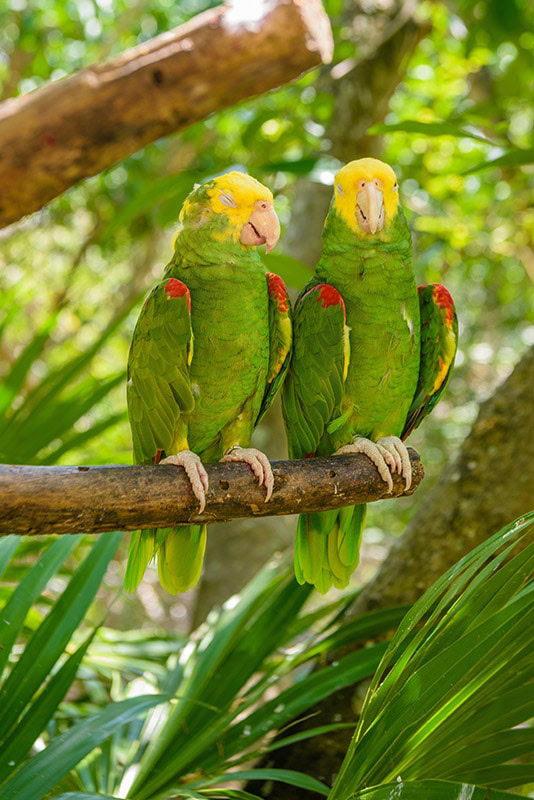
Double Yellow-Headed Amazon Parrot Colors and Markings
The main feature of this Parrot is their yellow head, hence their name. The rest of their body is green, so the color of their head is quite dramatic. Younger birds look a bit different. They usually have a dark grey coloration, but their head becomes more and more yellow as they molt. Eventually, they will match the adult coloration. But this doesn’t occur until they are closer to 6 years old.
Even after the coloration has technically set in completely, the yellow markings may increase as they get older. Males and females look the same. You have to run genetic testing to sex them accurately.
There are no color variations for this species. For the most part, they all look the same. However, their coloration will vary as they age.

Caring for the Double Yellow-Headed Amazon Parrot
These birds are challenging to care for. They require a great deal of attention, which is difficult for many owners to provide. In many situations, it simply isn’t possible for most owners to give them all the time that they need.
We highly recommend ensuring that you have hours every day to commit to your bird before adopting one. They are athletic, so you should plan on giving them plenty of room and time to move and exercise. They love to fly if given enough space.
Since they are larger birds, they can be a bit destructive. A strong fly cage is recommended. They will probably try to destroy it out of curiosity, though. At the minimum, we recommend that the cage is 3 feet in either direction, with a play gym at the top.
Plenty of toys should be provided. The Double Yellow-Headed Amazon Parrot will try to tear these toys apart—that’s just how they play. Therefore, ensure that their toys are sturdy and plan on buying new ones regularly. Supervision is required because these birds will attempt to tear up your home too. Your couch and furniture can be easy targets for a bored parrot.
These birds need social interaction. If you don’t pay enough attention to them, they can become destructive and depressed. Stress-induced behaviors, like feather plucking, can occur. Therefore, ensure that you can give them at least 3–4 hours of your attention each day.
Preferably, this time should be split into multiple sessions. A few rounds of one-on-one time a day will be far more helpful than one long session in the evening.
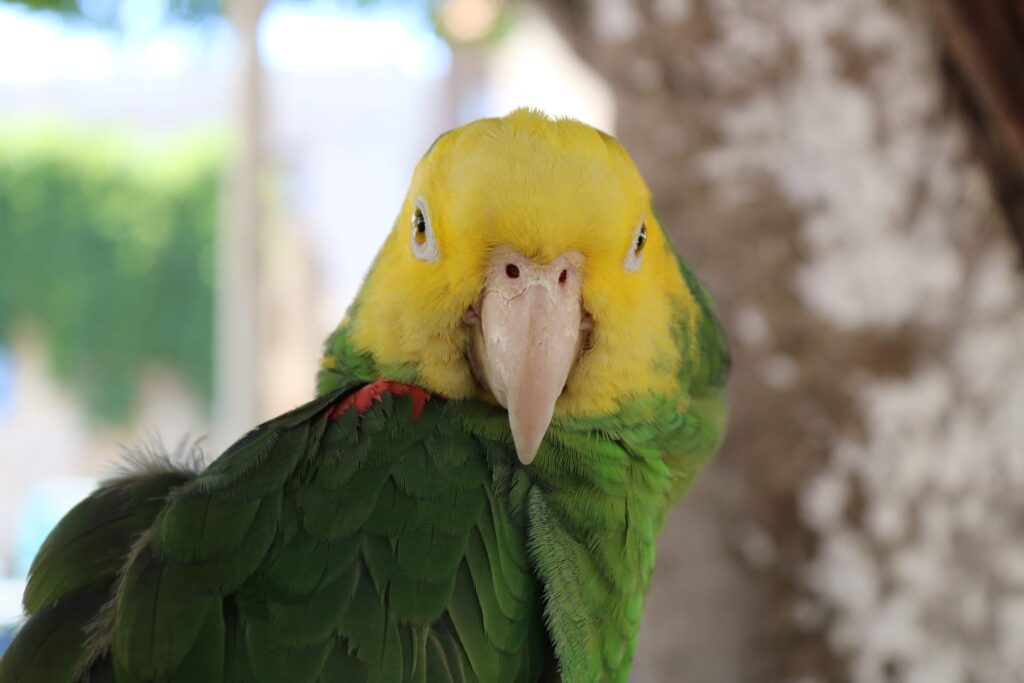
Common Health Problems
This species is prone to the same health problems that most parrots are. Nutritional deficiencies are sadly widespread. Many bird owners do not understand how to feed their parrots correctly. This leads to various problems. Vitamin A deficiency is most common, but other conditions can occur too.
Obesity can if Double Yellow-Headed Amazon Parrots are given too many treats. They may love sunflower seeds, but that doesn’t mean that they should eat tons every day. Regular exercise is also essential, though many owners may find that this takes more time than they have.
Polyomavirus can infect these parrots. This virus causes appetite loss and eventually, weight loss. It is deadly in some cases, as the affected bird will not eat enough to sustain themselves. Chlamydiosis is a bacterial infection that is also common. The bird’s feathers will fluff up and they may have nasal discharge.
Overall, though, these birds tend to be relatively healthy. If they are taken care of properly, they can live for a long time. Plan on this before you adopt them. Most parrots outlive their owners.
Diet and Nutrition
The nutrition of Double Yellow-Headed Amazon Parrots is critical. There is a great deal of misinformation on this topic out there, but it is essential for your bird’s overall well-being.
In the wild, they eat various seeds, nuts, berries, vegetation, and fruits. This varied diet is hard to replicate for pet parrots. For this reason, we recommend feeding them a pelleted food, combined with fruits and vegetables. This diet helps the bird consume all the nutrients that they need and provides them with tip-top nutrition.
Pelleted food works as a nutritional supplement, as it is often formulated to be high in the nutrients that your pet needs. However, most birds will also benefit from raw and fresh foods, like fruits and vegetables. Be sure to offer foods high in vitamin A, as this is a common deficiency. Calcium is also essential and can be added easily through the correct vegetables. When deciding what fresh foods to give your parrot, consider focusing on those with higher levels of these vitamins.
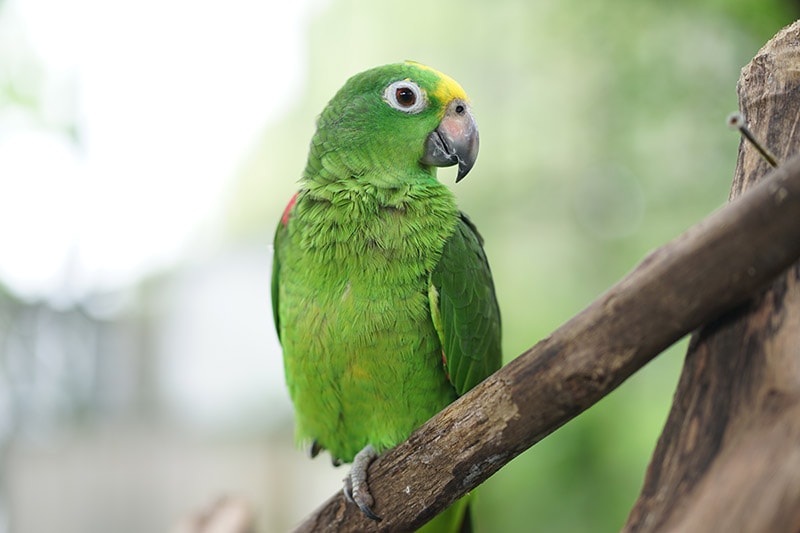
Exercise
If these birds are not exercised properly, they can quickly become overweight and obese. Like with all animals, too much body fat can cause all sorts of problems for these Double Yellow-Headed Amazon Parrots.
You should plan on giving your bird at least 3 to 4 hours of exercise each day. This should be done outside of the cage. These birds can get into things quickly, so you should plan on providing constant supervision.
This exercise period will enable your bird to burn excess calories, staying in tip-top shape. It will also help them stretch their muscles and provide a great deal of mental stimulation.

Where to Adopt or Buy a Double Yellow-Headed Amazon Parrot
We highly recommend purchasing your Double Yellow-Headed Amazon Parrot from a breeder. These birds are not good at adapting to moves. They remember their people and will become upset when separated.
Furthermore, there is no way that a pet store can provide them with the proper socialization and exercise. Without their needs being met, these parrots will quickly become stressed and exhibit feather plunking and similar behaviors. So, purchase them from a breeder if you can. It is unlikely that you will find a healthy Double Yellow-Headed Amazon Parrot in most stores. These birds usually cost around $2,000 to $3,000 when purchased from a breeder. This may seem expensive, but it is primarily due to the considerable time commitment required for breeding these parrots.
These parrots are common occurrences at rescues if you have one near you that accepts birds. They live for a long time, and many are displaced after their owners can no longer care for them.
Of course, make sure you interview the breeder and check on the bird before paying any money. Not all breeders are created equal. Any qualified breeder will allow you to see the parrot, their living conditions, and their parents before adopting. Cramped cages, unanswered questions, and inactive birds should be avoided.


Conclusion
The Double Yellow-Headed Amazon Parrot is widely known for their ability to talk. They are brilliant birds and can be trained with some ease. They are extremely friendly and bond well with at least one family member. They tend to be one-person birds, so they may not be best for families.
Their high intelligence leads to them requiring quite a bit of care, though. They need extensive socialization each day and at least 3–4 hours of supervised play outside of their cage. That’s a great deal of time for most people. Be sure you can commit before you adopt one of these birds. Otherwise, they could develop health problems and exhibit stress-induced behaviors, like feather plunking.
The Double Yellow-Headed Amazon Parrot can makes an excellent pet—just be sure you can provide them with the appropriate care.
Featured Image Credit: J.A. Dunbar, Shutterstock
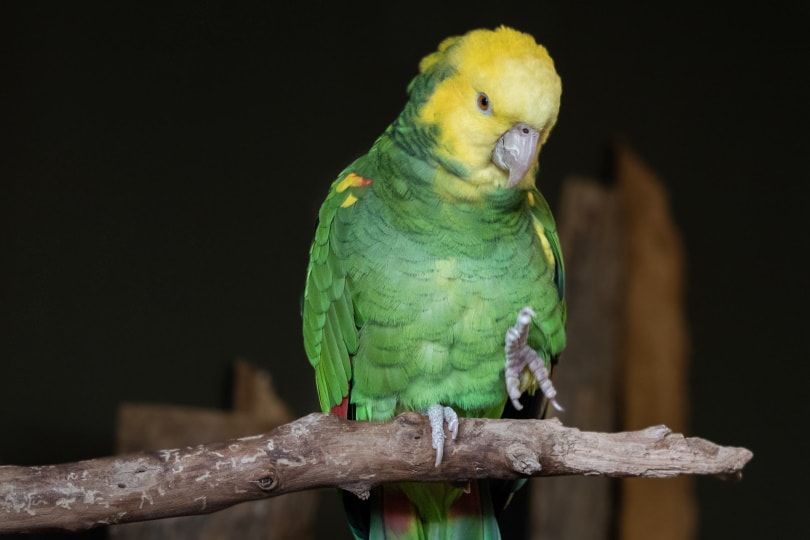





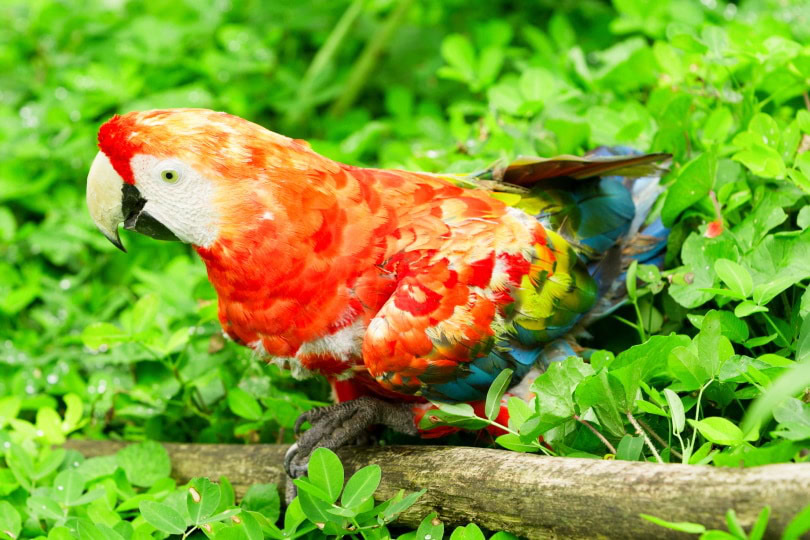
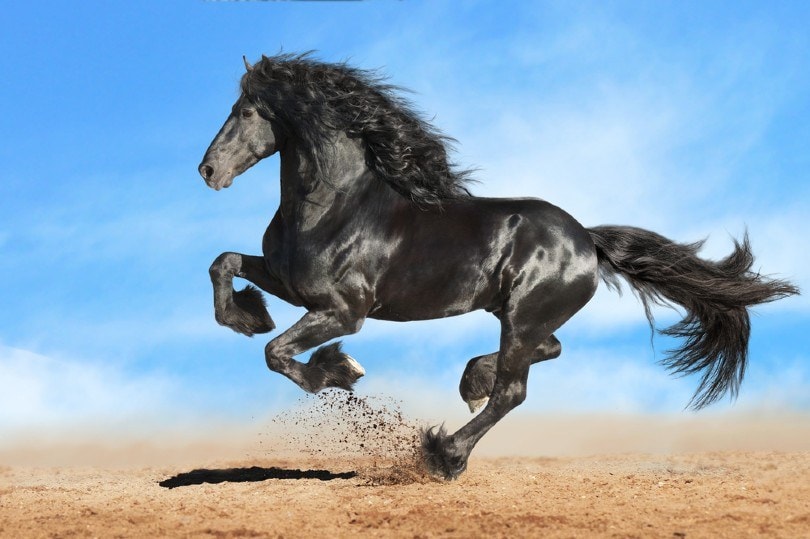
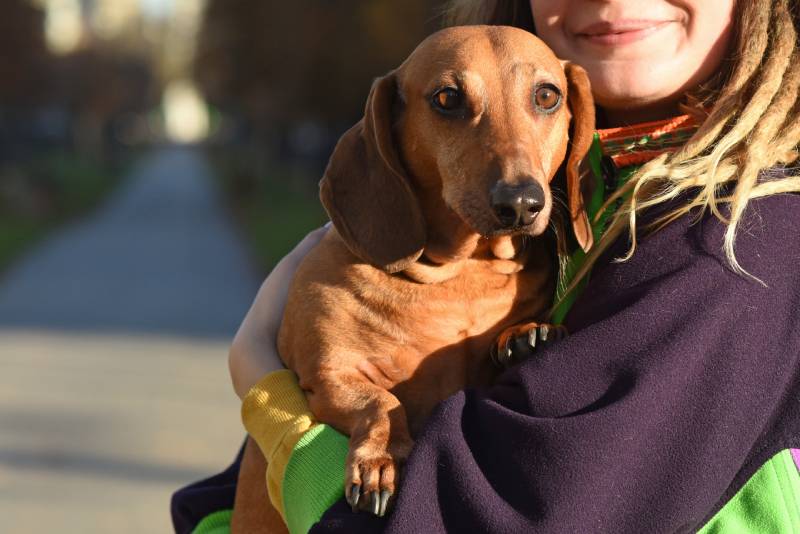


2 Responses
My sister says, Princess Diana, a double yellow headed Amazon Parrot, considers me her mate, rather than to have bonded with me….she is all about me in every way imaginable. Follows me all around the house, flying mostly on occasion walking. If I leave a room and she can’t follow me, she yells for me, she calls me Mom most of the time. I can have her on my arm and carry her, she sits on the arm of my couch to be near me, always wanting her neck area petted. But I am the only person she allows unlimited access for touching, others she tries to bite.
She has a play center and her cage, in different rooms on opposite sides of the home. She flies back and forth multiple times daily. Both areas have toys, water and food dishes. The cage is left open most of the time and is in itself another play area. My children are grown and out of the house and we have no other pets.
My biggest concern is her aggressive behavior towards my husband, is there a way we can fix this? She is almost always trying fly at him attempting to harm him if she can. So when not in the office with her play center, we usually have to close her cage when he is home. We are also curious about breeding patterns if she should have a bird friend or mate, is there certain ages for breeding or is it just her possessive nature that makes her act out?
We got Diana upon the death of my mom. She first came into our family through my youngest sister, but her autistic son couldn’t handle her in the home. My Mom had Diana until she passed almost 3years ago. She then lived with another of my sisters until I brought her to my home. Only because said sister travels frequently and Diana had already proved to everyone her preference was with me. As I am a frequent visitor and would care for Diana when my sister traveled. From the very first home she lived with in our family she has always showed a marked preference for me.
We believe her to be around the age of 30, we were told she was 20 when she came to our family 10 years ago.
I work from home and could give her all the attention she loves.
Dear Bobbi Jo,
thank you very much for sharing your story with us. It is lovely to hear about the great relationship you have with Diana, however, we are also sorry to hear about your struggles with her behavior. Since your questions would need a lot of information to be answered, we would like to offer you an appointment with our aviary veterinarian. Please contact us by email at [email protected] so we can set you up with our expert. He will be happy to give you all the answers and advice.
Best wishes.